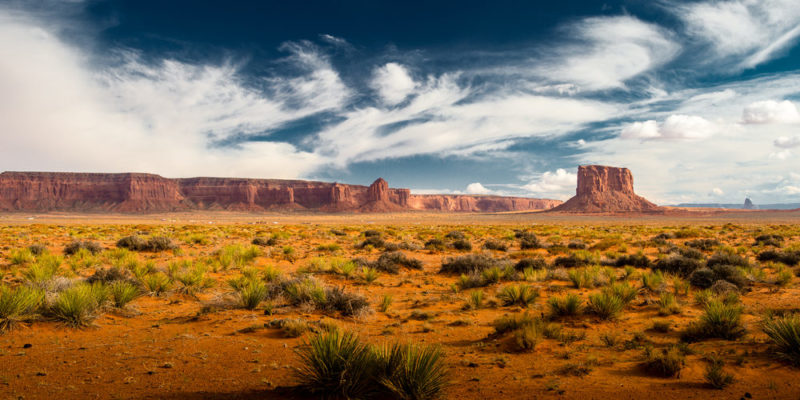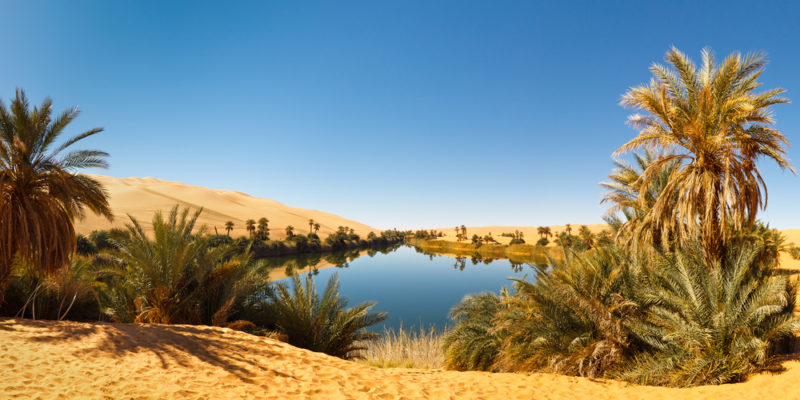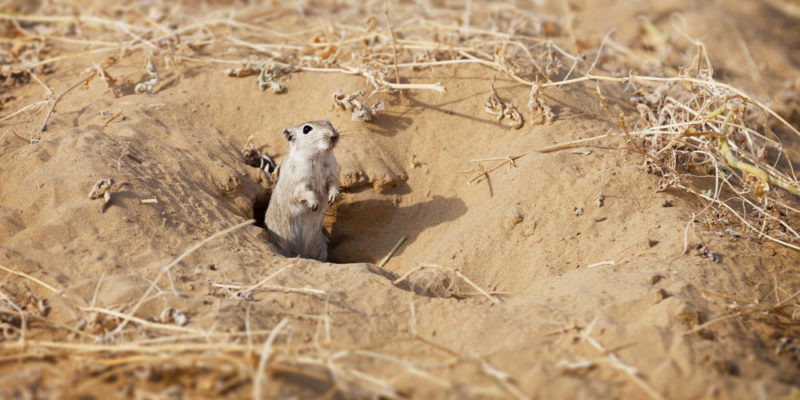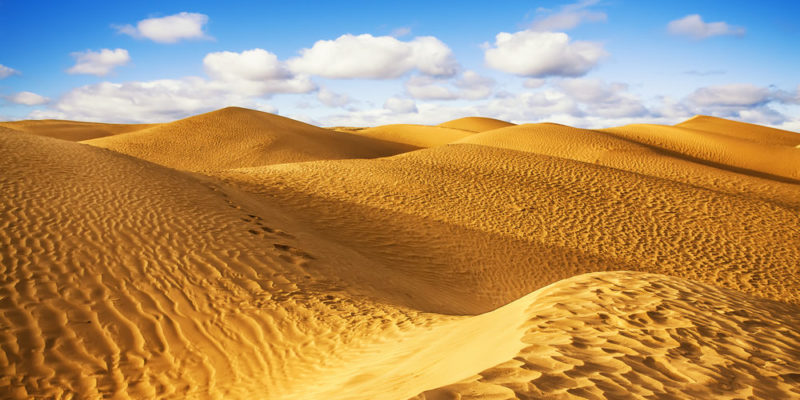We explain what a desert is, the climates it presents and how it is classified. Also, what are its characteristics, flora, fauna and more.
What is a desert?
The desert is a very frequent bioclimatic landscape on the earth's surface, characterized by its very low rainfall and scarce presence of fauna and flora, given the low levels of humidity. Although the traditional image of the sandy desert alludes to warm and equatorial climates, the truth is that those located on the arctic plateau or in the tundra also count as deserts .
Deserts are the product of different erosion processes , such as wind (given its high presence of winds that even form sand storms ) or the impact of solar radiation. The degree of intensity of these factors will depend on many characteristics of the desert, such as the type of sand formed or the nature of the soil.
Desert Features :
Worldwide spread

Considered in their entirety, deserts occupy almost a third of the earth's surface , about 50 million square kilometers. 53% of them correspond to hot deserts and the rest to frozen deserts.
They are distributed throughout the continents , the best known being the Saharan regions in North Africa , northern Mexico , the Asian tundra in Russia, Greenland and Alaska, as well as southern Chile and Argentina , or the platform from the arctic
-
Climates
- Semi-arid (steppe). With an average of 250 to 500 mm of precipitation per year, they cover 15% of the earth's surface. They are situated on the edges just of the deserts.
- Arid . Annual rainfall of 25 to 250 mm maximum, cover 16% of the earth's surface and constitute the bulk of the deserts.
- Hyperarid. The margins of drought in these areas are such that it usually does not rain for years or not at all. They represent barely 4% of the earth's surface, including the polar deserts and the heart of the great hot deserts.
Temperatures in these areas are usually extreme, with huge thermal variations between day and night. Hot deserts can see highs above 40 degrees Celsius during the day and drop below zero at night. In the case of polar deserts, the temperature remains well below zero (-40 °C), depending on the stationary cycle.
-
Types of desert
 According to their geographical location and prevailing climatic pattern, it is possible to classify deserts into several types:
According to their geographical location and prevailing climatic pattern, it is possible to classify deserts into several types:
- tropical deserts. Located in the equatorial fringe of the planet, they are under the effect of trade winds that prevent the formation of cloud cover and maximize solar radiation on the ground. Most of the planet 's deserts are of this type, including the largest of all, the Sahara in North Africa, whose temperatures reach 57 °C.
- Mid-latitude deserts. They are found in subtropical zones of high atmospheric pressure, generally located in drainage basins distant from water sources such as oceans or lakes . The Sonoran desert in Mexico is of this type.
- Deserts from auger to humid air. They are a consequence of the action of large mountainous barriers that restrict the access of the wind and therefore of the humidity. The Judean desert in Israel is a clear example of this.
- coastal deserts. Usually located on continental edges and under the effect of complex wind systems that prevent the formation of precipitation and result in an unstable climate system. The Atacama desert in Chile, the driest in the world, belongs to this classification.
- monsoon deserts. Produced by the action of the monsoons (seasonal wind system), which are born in the ocean and lose their moisture as they move over the continental shelf, rapidly discharging it and drying the most remote areas. The Thar desert in Pakistan is a clear example.
- cold deserts. Generally located in areas of high altitude and low rainfall, they contain the same aridity as their warm counterparts, but with higher atmospheric pressure margins. The high Andean Puna illustrates this case well.
- polar deserts. With temperatures below the freezing point of water , they are extensions of ice (and snow in some cases) with practically no annual precipitation, on rock or gravel beds. The central ice sheet in Greenland is a case in point.
Floors

Deserts usually have two different types of soil , depending on the impact of erosion on the materials that compose it. Thus, it is possible to speak of sandy soils, obviously composed of the rocky microparticles that make up the sand, and that the wind pushes to form dunes; and also of rocky or stony soils, composed of larger pebbles or accumulations of stone of various kinds.
It should also be noted the case of polar deserts, whose surface is entirely covered by ice , so it cannot really be treated as a type of soil, since it can even be found kilometers below the frozen layer.
-
Paleodeserts
The Argentine Ischigualasto (Valley of the Moon), the Kalahari desert and the Sand Hills of Nebraska are considered paleodeserts, and intense archaeological recovery work and collection of ancient samples are carried out in them.
Desert flora

The vegetation of the deserts is, in principle, scarce, given the very low humidity margins . What exists has adapted to resist such adverse conditions, and it is generally xerophilous type vegetation, with a predominance of thorny and resistant plants, such as cacti, as well as weeds and, in the best of cases, low-lying shrubs. height.
In the oases, on the other hand, the presence of water allows a greater proliferation of vegetation, with the presence of palm trees and larger bushes.
-
Desert wildlife
 Contrary to popular belief, there is a well-defined desert ecosystem , albeit well adapted to such an adverse environment and focused on preserving body moisture. Perhaps for this reason reptiles (such as snakes ), insects ( ants , beetles) and arachnids ( scorpions , spiders) abound.
Contrary to popular belief, there is a well-defined desert ecosystem , albeit well adapted to such an adverse environment and focused on preserving body moisture. Perhaps for this reason reptiles (such as snakes ), insects ( ants , beetles) and arachnids ( scorpions , spiders) abound.However, there are also numerous desert rodents , sheltered in burrows far from the sun , as well as birds of prey and scavengers, or camelids with a high resistance to drought.
Mineral resources
Revealed by erosion and protected from moisture , many mineral resources are found in deserts, such as oil fields (especially in the Middle East) or heavy metals .
The desert sand, likewise, is usually rich in calcareous elements and salts , which is why salt flats are often found in desert areas, such as in the Uyuni region in Bolivia . This type of desert drains even more moisture from the environment, thus feeding back its aridity.
-
Largest expanses in the world
 The largest desert areas in the world are:
The largest desert areas in the world are:
- The arctic and antarctic polar deserts. With 13,726,000 and 13,829,000 square kilometers of surface respectively.
- Sahara desert. In North Africa, with 9,065,253 square kilometers.
- Australian desert. In Oceania , with 2,330,000 square kilometers.
- Arabian desert. In the Arabian Peninsula, with 2,300,000 square kilometers.
- Kalahari desert. In southern Africa, with 930,000 square kilometers.
- Patagonian desert. In South America , with 670,000 square kilometers.
Alien desert landscapes
There are desert extensions outside our planet, although the only ones that seem to have wind displacements are those of Mars , where there is a circumpolar sand desert of almost 5,000,000 square kilometers. These deserts present high margins of wind abrasion , since the wind drags a large number of suspended particles at very high speeds.
The above content published at Collaborative Research Group is for informational and educational purposes only and has been developed by referring reliable sources and recommendations from technology experts. We do not have any contact with official entities nor do we intend to replace the information that they emit.
Passionate about understanding and contributing to a world that does not stop changing. New forms of Work, Sustainability and Technology. For many years he has worked as a creative for large international companies. He has a Ph.D. in information technology and he has been doing quantitative research in the interdisciplinary areas of information systems, cyber security, data analytics and artificial intelligence. He continue to look for creative solutions through technology to help companies to be more humane and sustainable..
Leave a reply
Your email address will not be published. Required fields are marked *Recent post

Sport: What Is It, Types, Risks, Features, Characteristics and Examples

Dogs: Emergence, Features, Characteristics, Feeding and Breeds

Story: Definition, Elements, Structure, Features and Characteristics

